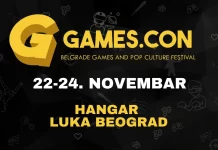Not every big idea in videogames is immediately celebrated. As an inherently iterative medium, the first take on a concept is often a bit wonky and unpopular. Public opinion being what it is, a great idea can be left on the table for years. Here’s a list of 5 games with big ideas that were YEARS ahead of their time
Herzog Zwei
What it did before anyone else: While incomplete in its vision, it did real-time action-strategy before anyone else.
Long before the mouse became the controller of choice for real-time military action, the console-exclusive Herzog Zwei had a lot of the fundamentals down on the whole unit-building, base-sieging, control-point-holding tug-of-war that we’d come to know and love. Only instead of giving orders from afar, you piloted a transforming mech/jet hybrid capable of airlifting units around the field and supporting them in combat. It was pretty demanding to play.
It was never that popular in its time; I hadn’t even heard of it until the early 2000s. But Herzog Zwei was undeniably swinging for the fences and ahead of its time. Even if Westwood Studios would nail down the ‘true form’ of the genre on PC with Dune 2 in 1992, this one holds a special place in my heart. And not just mine, clearly, because there are modern successors still being released to this day.
While Dune 2 may have become the dominant evolutionary branch of the RTS genre, Herzog Zwei’s recessive genes occasionally bubble to the surface in the likes of Sacrifice, Brutal Legend, Tooth and Tail, Airmech and most recently Minecraft Legends. Only one of them lets you pilot a giant transforming robot, though, which is clearly the most important part.
Jurassic Park: Trespasser
Released: October 1998 | Developer: DreamWorks Interactive
What it did before anyone else: An entirely physics-driven world, from crates to ragdolls to the player’s own body.
Jurassic Park: Trespasser was a wildly ambitious immersive sim before the term was popularized by Deus Ex creator Warren Spector. Its entire dinosaur-infested world was physically driven. Every building, every piece of rubble, every crate and every dinosaur had weight and heft. The problem was that none of that worked right. It was a trainwreck, barely playable, and held back further by the player’s key method of interaction with the world: A physically modeled and very floppy arm.
Requiring a downright arcane combination of mouse and keyboard inputs to control, you could waggle your virtual arm around to grab and shove objects, hold guns, try to fire them and flailingly interact with the world. It sometimes worked, but usually didn’t. Special mention must be given to how the game displayed the heroine’s health bar in lieu of a traditional videogame HUD: an increasingly colour-filled tattoo on her left breast.
Nowadays, physics-driven worlds are standard in games, but it wasn’t until the current generation of VR that Trespasser’s vision finally bore fruit. Anyone who’s familiar with it and has played Bonelab/Boneworks will see the resemblance. The springy physics, the sometimes-finicky player body modelling and the noodly, recoil-heavy guns work intuitively now in VR. VR games even commonly draw their HUD on the player’s body, although through lessons learned, it’s usually an arm or wrist, instead of chest. Usually.
Habitat
Released: 1986 | Developer: Lucasfilm
What it did before anyone else: It was a graphical MMO/social hangout before most people had heard of the internet.
While not the first online multiplayer game released, Lucasfilm’s Habitat—a curio from 1986—is the one that most resembles modern social hangouts like Second Life or VR Chat. Impressive considering that it’s closing in on forty years old now. It had customizable avatars with more varied appearances (and legs) than Zuckerberg’s cutting-edge ‘metaverse’, activities, in-world newspapers and hangout spots.
It’s honestly shocking just how closely it resembles modern virtual social spaces, with minigames, house customization, shopping systems and all the mod cons you’d expect from the 2010s, not 1980s. And the classy narration on Lucasfilm’s official promo video above is a cut above most of what we see today. Maybe I’m getting old, but that’s the vibe I want from the web.
Habitat’s ambitions were so far ahead of their time, and the cost of running the servers for it were so prohibitive, that it never saw anything beyond a small-scale beta release. It saw a cut-back relaunch under the name Club Caribe in 1988, after which it quickly faded from public view. In recent years, archivists have revived and ported it to a web client so as to preserve this fascinating piece of history. You can even run it on a real C64, if that’s your jam.
Hunter
Released: 1991 (Amiga) | Developer: Paul Holmes and Martin Walker/Activision
What it did before anyone else: This ambitious open-world shooter was a Just Cause, but a Far Cry from popularity.
The modern day sandbox shooter is a formula so familiar that half of the games released in the style are functionally identical. Steal vehicles, hoard guns, blow stuff (and wildlife) up, anger the locals and repeat until victory or death. Hunter on the Amiga nailed all that long before any 3D GTA existed.
It’s immediately familiar stuff to anyone who has played a modern Just Cause or Far Cry game. There’s an island archipelago overrun by enemy forces, and a general somewhere needing to be assassinated. By raiding enemy camps (and blowing up all their toys with rockets), gathering intel from the locals and bribing the occasional officer, the player’s goal is to narrow down the whereabouts of the one guy you’re actually meant to shoot.
While obviously way ahead of its time in ambition, and very graphically impressive (you’ll have to take my word on this one, zoomers) for 1991, it’s one of those games that’s more fun conceptually than to actually play. With stiff controls, a rigid camera angle and incredibly over-complicated inventory management, it feels a little too heavy on the sim and RPG elements to make for a pick-up-and-play action romp.
Rogue
Released: 1980 | Developer: A.I. Design
What it did before anyone else: Permadeath dungeon crawling in procedural death labyrinths.
Does Rogue need an introduction? It was the original. The dungeon crawl to begin all dungeon crawls. Just you, a cave network roughly hewn from raw ASCII, and a turn-based, procedurally generated quest to recover the Amulet Of Yendor from the abyss. This game helped teach me to read; K is for Kestrel (a cave-dwelling bird that hates adventurers), Q is for Quaff (a fancy word for drinking)—my version of Sesame Street was a bit more intense than other ’80s kids’.
As great as the original was, it didn’t have much influence on the industry at first outside of hardcore nerd circles. It’s easy to forget that the concept of the roguelike—now utterly ubiquitous across all genres and platforms—was once a curious little niche. A term that few had heard, and fewer could define without a lengthy argument. Nowadays it’s a marketing buzzword that gets slapped onto just about anything no matter how tenuously related to Rogue it is. But for a time, it was considered a toxic black mark on a game.
After Atlus released Baroque worldwide on the PlayStation 2 and Nintendo Wii (a 2007 remake of a previously Japanese-only 1998 dungeon crawl), many reviewers found themselves baffled and frustrated at the idea of a dungeon that reconfigures itself after every death, and where hours of progress can be lost in seconds. The backlash was so intense that when it came to release the next game in the Nethack-inspired Shiren The Wanderer series in the west, Atlus specifically asked the press not to refer to it as a roguelike, as reported here by Kotaku. Fortunately, few did as asked, and the term—and game formula—hit its heyday and mass acceptance not long after.






















